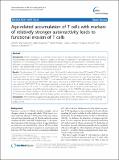| dc.contributor.author | Tatari-Calderone, Zohreh | |
| dc.contributor.author | Stojakovic, Milica | |
| dc.contributor.author | Dewan, Ramita | |
| dc.contributor.author | Le Bouder, Gama P. | |
| dc.contributor.author | Jankovic, Dragana | |
| dc.contributor.author | Vukmanovic, Stanislav | |
| dc.date.accessioned | 2012-04-24T15:38:31Z | |
| dc.date.available | 2012-04-24T15:38:31Z | |
| dc.date.issued | 2012-02 | |
| dc.date.submitted | 2011-11 | |
| dc.identifier.issn | 1471-2172 | |
| dc.identifier.uri | http://hdl.handle.net/1721.1/70114 | |
| dc.description.abstract | Background Thymic involution is a prominent characteristic of an aging immune system. When thymic function is reduced/absent, the peripheral T cell pool is subject to the laws of peripheral T cell homeostasis that favor survival/expansion of T cell receptors with relatively higher functional avidity for self-peptide/MHC complexes. Due to difficulties in assessing the TCR avidity in polyclonal population of T cells, it is currently not known whether high avidity T cells preferentially survive in aging individuals, and what impact this might have on the function of the immune system and development of autoimmune diseases. Results The phenotype of T cells from aged mice (18-24 months) indicating functional TCR avidity (CD3 and CD5 expression) correlates with the level of preserved thymic function. In mice with moderate thymic output (> 30% of peripheral CD62Lhi T cells), T cells displayed CD3lowCD5hi phenotype characteristic for high functional avidity. In old mice with drastically low numbers of CD62Lhi T cells reduced CD5 levels were found. After adult thymectomy, T cells of young mice developed CD3lowCD5hi phenotype, followed by a CD3lowCD5low phenotype. Spleens of old mice with the CD3low/CD5hi T cell phenotype displayed increased levels of IL-10 mRNA, and their T cells could be induced to secrete IL-10 in vitro. In contrast, downmodulation of CD5 was accompanied with reduced IL-10 expression and impaired anti-CD3 induced proliferation. Irrespective of the CD3/CD5 phenotype, reduced severity of experimental allergic myelitis occurred in old mice. In MTB TCRβ transgenic mice that display globally elevated TCR avidity for self peptide/MHC, identical change patterns occurred, only at an accelerated pace. Conclusions These findings suggest that age-associated dysfunctions of the immune system could in part be due to functional erosion of T cells devised to protect the hosts from the prolonged exposure to T cells with high-avidity for self. | en_US |
| dc.description.sponsorship | National Institutes of Health (U.S.) | en_US |
| dc.description.sponsorship | National Heart, Lung, and Blood Institute (1U54 HL090503 (ZT-C)) | en_US |
| dc.description.sponsorship | National Institute of Allergy and Infectious Diseases (U.S.) (Grant 1R01 AI48837) | en_US |
| dc.description.sponsorship | National Institute of Allergy and Infectious Diseases (U.S.) (Grant 1R01 AI41573 ) | en_US |
| dc.publisher | BioMed Central Ltd | en_US |
| dc.relation.isversionof | http://dx.doi.org/10.1186/1471-2172-13-8 | en_US |
| dc.rights | Creative Commons Attribution | en_US |
| dc.rights.uri | http://creativecommons.org/licenses/by/2.0 | en_US |
| dc.source | BioMed Central Ltd | en_US |
| dc.title | Age-related accumulation of T cells with markers of relatively stronger autoreactivity leads to functional erosion of T cells | en_US |
| dc.type | Article | en_US |
| dc.identifier.citation | Tatari-Calderone, Zohreh et al. “Age-related Accumulation of T Cells with Markers of Relatively Stronger Autoreactivity Leads to Functional Erosion of T Cells.” BMC Immunology 13.1 (2012): 8. | en_US |
| dc.contributor.department | Sloan School of Management | en_US |
| dc.contributor.mitauthor | Le Bouder, Gama P. | |
| dc.relation.journal | BMC Immunology | en_US |
| dc.eprint.version | Final published version | en_US |
| dc.type.uri | http://purl.org/eprint/type/JournalArticle | en_US |
| eprint.status | http://purl.org/eprint/status/PeerReviewed | en_US |
| dc.date.updated | 2012-03-13T16:20:19Z | |
| dc.language.rfc3066 | en | |
| dc.rights.holder | Tatari-Calderone et al.; licensee BioMed Central Ltd. | |
| dspace.orderedauthors | Tatari-Calderone, Zohreh; Stojakovic, Milica; Dewan, Ramita; Bouder, Gama Le; Jankovic, Dragana; Vukmanovic, Stanislav | en |
| mit.license | PUBLISHER_CC | en_US |
| mit.metadata.status | Complete | |
